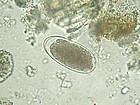Difference between revisions of "Category:Trichostrongyloidea"
Jump to navigation
Jump to search
| Line 29: | Line 29: | ||
*The prepatent period is typically about 3 weeks | *The prepatent period is typically about 3 weeks | ||
| − | + | ||
[[Category:Bursate_Nematodes]] | [[Category:Bursate_Nematodes]] | ||
Revision as of 11:22, 21 May 2010
Trichostrongyloidea
General Appearance
- Bursate
- Most members of this superfamily look like short lengths of cotton (typically 0.5-2cm)
- The spicules of each species have a characteristic shape
- The heads have no distinct features
General Life-Cycle
- The egg is approximately 80µm long, oval, thin-shelled, contains 4-16cells (i.e. it is a typical strongyle egg)
- Egg → L1 → L2 → L3 (this occurs on the ground)
- L1 and L2 feed on bacteria
- L3 is the infective stage
- L3 is ensheathed (i.e. the L2 cuticle is retained after moulting as an "outer skin")
- L3 cannot feed, but contains a finite amount of stored food to provide energy for movement
- Infection is by ingestion of the L3
- L3 → L4 → adult (this occurs in the stomach or small intestine)
- Parasitic development initially occurs in gastric glands or intestinal crypts (depending on species)
- Adults are situated on the mucosal surface
- The prepatent period is typically about 3 weeks
Subcategories
This category has the following 2 subcategories, out of 2 total.
Pages in category "Trichostrongyloidea"
The following 8 pages are in this category, out of 8 total.
